Kišava
| Kišava Кишава Këshavë | |
|---|---|
| Village | |
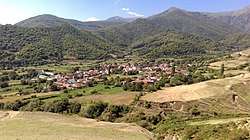 Kišava | |
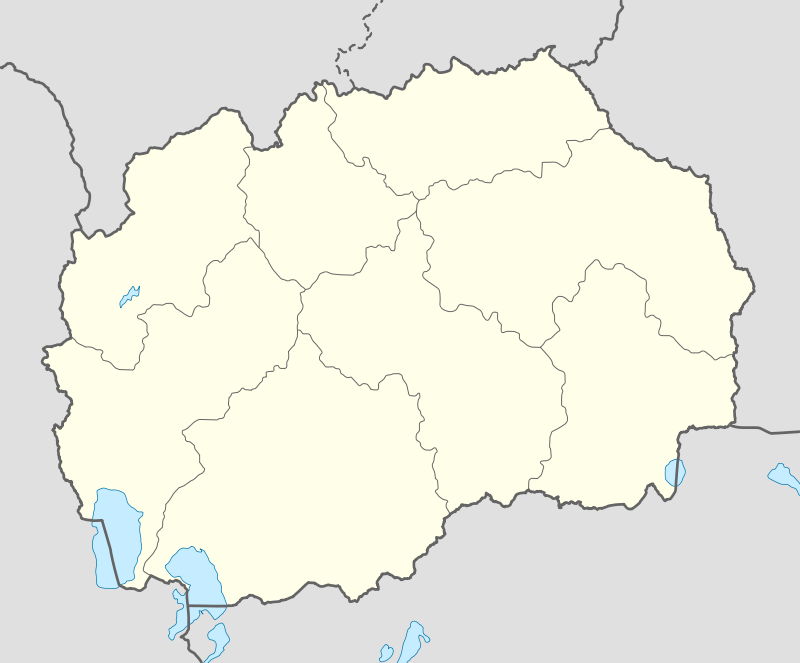 Kišava Location within Macedonia | |
| Coordinates: 40°52′59″N 21°19′0″E / 40.88306°N 21.31667°ECoordinates: 40°52′59″N 21°19′0″E / 40.88306°N 21.31667°E | |
| Country | Republic of Macedonia |
| Municipality | Bitola Municipality |
| Statistical region | Pelagonia Statistical Region |
| Elevation | 881 m (2,890 ft) |
| Population (2002) | |
| • Total | 308 |
| Time zone | UTC+1 (CET) |
| • Summer (DST) | UTC+2 (CEST) |
| Postal code | 7223 |
| Area code(s) | +389 047 |
| Car plates | BT |
| Website | . |
Kišava, (Macedonian: Кишава, sometimes transliterated Kishava, Albanian: Këshavë) is a village in the municipality of Bitola, Republic of Macedonia. It is located about 20 km south of Bitola and is accessed by narrow mountainous roads. The main road that links this village to the near city is in need of maintenance as it was built in the 1970s.
Demographics
Kišava has traditionally and exclusively been populated by Muslim Albanians.[1] From the 1950s onward, people from Kišava began migrating to nearby settlements like Medžitlija or going abroad to other countries for better opportunities. As such, a sizable diaspora from the village exists in the suburb of South Dandenong in Melbourne, Australia.[2]
According to the 2002 census, the village had a total of 308 inhabitants.[3] Ethnic groups in the village include:[3]
- Albanians 307
- Macedonians 1
Economy
The main occupation of villagers in Kišava is farming and herding. The most known product of this village is the Kišava bean. Local villagers also rely on milk production as their main income. In recent times, the local economy has experienced a downturn affecting Kišava with expenses going up and income somewhat in decline.
Kišava is surrounded especially on its western confines by the Baba mountain range and frequented by people who come to camp at a place called "Demikapt". Its local fauna is full of flowers. Tourists come to Kišava, often from Canada, Australia, United States, Switzerland and Turkey. Many Albanians from the village diaspora also come back to Kišava for a visit, especially during the summer holiday months.
Gallery
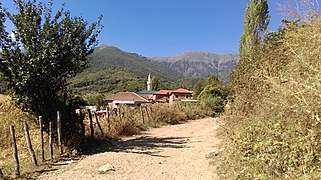 Kišava village
Kišava village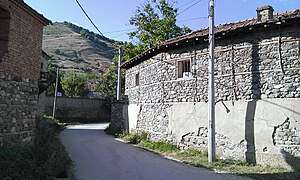 Traditional architecture of Kišava
Traditional architecture of Kišava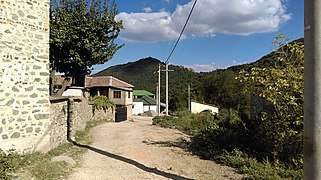 Road in Kišava
Road in Kišava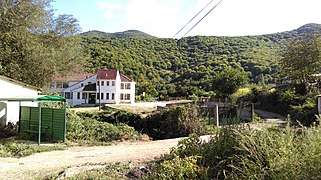 Primary school in Kišava
Primary school in Kišava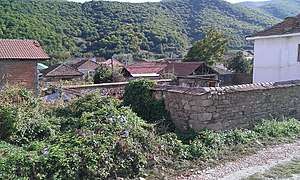 Houses in Kišava
Houses in Kišava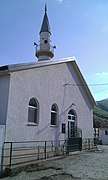 Mosque of Kišava
Mosque of Kišava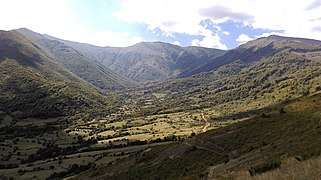 Fields of Kišava toward the Baba mountain range
Fields of Kišava toward the Baba mountain range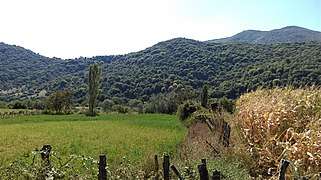 Fields of Kišava
Fields of Kišava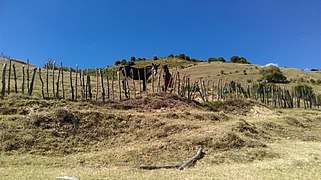 Horses grazing on Kišava mountain slope
Horses grazing on Kišava mountain slope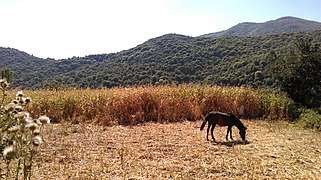 Horse grazing in Kišava field
Horse grazing in Kišava field Kišava village
Kišava village
References
- ↑ Godišen zbornik (1969). Volumes 17-18. Univerzitet vo Skopje. Geografski institut. p. 171. "Чисто албански села сега се: Арматуш, Кишава, Острец, Злокуќани, Снегово, Старо Змирново, Саждево, Јакреново, Борино, Норово, Древеник. При ослободувањето од турското владеење во 1912 г. оваа област имала повеќе чисто албански села."
- ↑ "After World War II". Immigration Museum. Retrieved 30 November 2015. "Albanian migration in the wake of World War II is intimately connected with the turbulent political, social and economic conditions of the homelands: Albania, Kosova, Macedonia and Montenegro. Following the war, the establishment of a Stalinist dictatorship in Albania and a centralised communist regime in former Yugoslavia had profound and deeply tragic consequences. A small number of refugees from Albania, and especially Albanians from the Prespa region in south-western Macedonia, were resettled in Australia. Sharing a common dialect – Toskë, one of the major southern Albanian dialects – and a long history of intermarriage and cultural exchange with Albanians from the Korçë region, they found a ready sense of community and solidarity with the early kurbetxhi in Victoria and elsewhere in Australia. With mass migration to Australia during the 1960s and 1970s, the Prespa Albanians and those from the nearby villages of Këshavë and Ostrec formed a large proportion of the Albanian community in Australia, numbering 5,401 in 1991. The majority of these mostly Muslim Albanians settled in Victoria, principally in Melbourne’s industrial, working-class suburbs of Dandenong, Footscray, Yarraville, Altona, St Albans, Preston, Thomastown and Lalor."
- 1 2 Macedonian Census (2002), Book 5 - Total population according to the Ethnic Affiliation, Mother Tongue and Religion, The State Statistical Office, Skopje, 2002, p. 69.
